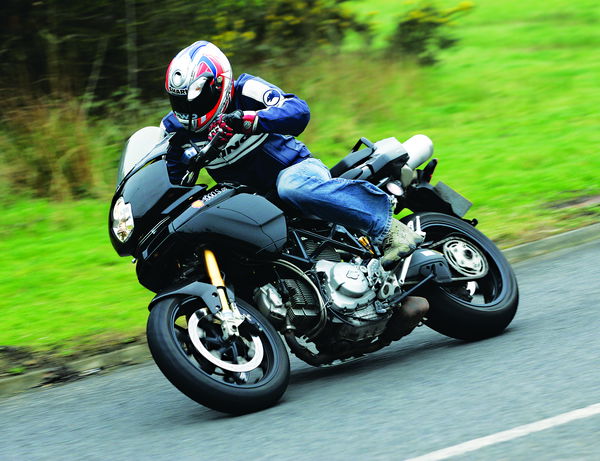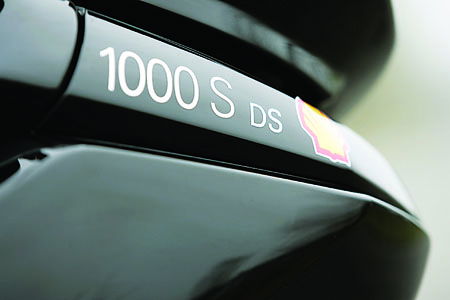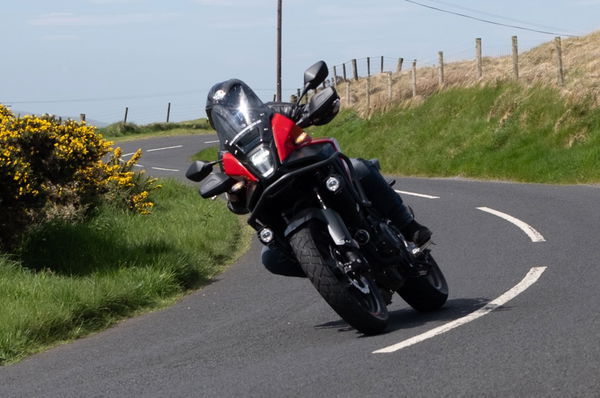Road Test: Ducati Multistrada 1000DS
I have to say I'm a bit of a Multistrada fan. It's one of those strange bikes that, initially, I wanted to hate, but has since really grown on me.

 |
I remember when it was first launched in late 2001. There was a big ceremony, lots of talk about a bike that can go on any roads - 'Multistrada' is Italian for 'many roads' - and then they pulled the covers off and revealed the bike...
The reaction was one of hushed shock, because the Multistrada looks like nothing else - except possibly a Dyson upright vacuum. Ducati is known for producing iconic machines such as the 916 and Monster and now it unveils something that looks like the result of a night of taboo sex between a Cyberman and a supermoto. But then I rode one.
And here is the big problem that faces Ducati. Because when you get a chance to ride a Multistrada you'll realise what a blinding bike it really is. Talk about an image crisis, which is probably why the bike hasn't sold as well in the UK as it has throughout the rest of Europe.
Over here we are still very image-led when it comes to buying bikes. In Europe the Multistrada has been a massive hit, and was Ducati's fastest-selling bike ever in its first year of production. Conversely, in the UK we still snap up Ducati's sportsbikes rather than its more practical all-round machines.
So why is this? In Europe the biking culture is a bit different to ours. Here in the UK biking is more of a leisure activity than a way of life. Hence the reason image bikes such as sportsbikes are the big sellers. In Europe things like Yamaha TDMs, BMW GSs and Suzuki SV650s are the big sellers, because they're do-it-all machines rather than fashion statements. Which is why the Multistrada has been a hit.
How can Ducati get over this image crisis in the UK? One way is to produce a higher specification Multistrada, so enter the Multistrada 1000 S DS.
As any good backstreet special builder knows, the best way to trick-up a bike is to simply add on some carbon bits and high-spec big name suspension components. Which is exactly what Ducati has done. The only differences between the higher-specification Multistrada and the base model are the …hlins forks and shock, carbon front and rear mudguards and some carbon cam-belt covers. That's your lot, and it will cost you £700 over the standard bike's £7750 at £8495. So that's a suspension upgrade and some cosmetic bling for £700, which actually isn't bad value really, especially considering the difference it makes to the look of the bike.
Riding around on this black Multistrada S I couldn't help but notice the number of heads it turned, far more than I remember when I rode a standard red Multistrada last year. Personally I still don't like the bike's front end, but in black, with the gold …hlins forks, it looks bloody good. I think it's something to do with the dark colour hiding some of the odder angles, or at least blending them into each other, but whatever it is, it works. A simple colour change and a splash of gold has taken a bike that looks plain odd to one that looks mean and moody.
And it makes you ride accordingly. If you want a tool to help you ride like an idiot then look no further than this Ducati. But conversely if you want to knock off the commuting miles then it is also more than willing to oblige.
Despite the off-road-ish style of the bike, the Multi's seat height isn't that high and the bars are quite narrow, which is useful for avoiding car mirrors when filtering. New for 2005 throughout the whole Multistrada range is a more thickly-padded seat, replacing the cripplingly uncomfortable one from previous years, as well as new mirrors with longer stalks and a taller screen - all features aimed at making the bike more practical, and evidence that Ducati listens to its customers. But while the new seat is definitely better with far more padding, and the screen a bonus on longer journeys, (although taller riders will find the need to duck slightly to get behind it), the mirrors are still next to useless. The problem is they are styled to look good first and reflect what's going on behind second. And while we're talking practicality, whoever put the ignition barrel where it is needs shooting. It's too close to the bars and makes getting the key in a fiddly operation. But I guess it wouldn't be a Ducati unless it didn't have a few minor 'character quirks'.
Or a heavy clutch for that matter. Riding through town you can't help but notice how heavy the Multistrada's clutch is. I usually use just two fingers to operate the clutch but after a half-hour journey on the Multistrada I had to use all four to ease the pain. Ducati do have a lighter clutch system - used on the 620-engined range of bikes and the Monster S2R - I just wish it would extend it to bigger capacity machines.
Get it out of town and the clutch becomes less of a problem. Although it's a perfectly capable commuter, the Multistrada really excels away from the city streets. The whole philosophy behind the Multistrada is 'fun', and it really is a blast to ride on twisty roads. Every time I ride a Ducati with the air-cooled 1000cc it impresses. From low down the V-twin thumps forward at a surprising rate of knots. Bang the throttle open in first gear and the front wheel will rise, which adds to the fun, but it's the amount of torque everywhere across the rev range that makes the engine so nice to use. And while the clunky gearbox isn't especially pleasant to use, it isn't all that bad.
To be truthful the 'S' version's Ohlins suspension doesn't really make a hell of a difference on the road. The upright riding position, combined with the 17-inch wheels and high seating position, makes it unlike any other bike around, but it works, and works really well. I've ridden Multistradas on track as well, and they are excellent. The flat bars help throwing it around and the Pirelli Scorpion tyres provide excellent levels of wet and dry grip.
So what's stopping people buying the Multistrada? British snobbery. As an all-rounder the Multistrada is a great bike, it's just a shame that people can't see past its unique and very individual look. I reckon the black-coloured 'S' version (it's also available in red) combined with gold …hlins goes a long way to improving the bike.
If you want a practical machine that is a cracking good laugh to ride the Multistrada is well worth a look-in. Just bear in mind that, being a Ducati, the service costs are going to be higher than with a Japanese bike, and it does have some irritating quirks.
Is the S worth the extra cash over the standard Multi? Although differences in feel are negligible and the performance the same, I would still go for the S because of its added kudos. If you aren't that concerned about the …hlins then the standard Multistrada is still a good buy, just make sure you get the 2005 model with the updated seat and screen as they really do make a difference, although the new mirror stalks aren't quite so effective!
VERDICT
The Multistrada is an odd-looking but surprisingly good bike. This new S model is the one to get, especially in black
SPECS
TYPE - ALL-ROUNDER
PRODUCTION DATE - 2005
PRICE NEW - £8495
ENGINE CAPACITY - 992cc
POWER - 84bhp@8000rpm
TORQUE - 61.5lb.ft@5000rpm
WEIGHT - 200kg
SEAT HEIGHT - 820mm
FUEL CAPACITY - 20L
TOP SPEED - 130mph
0-60 - n/a
TANK RANGE - n/a

There was a big ceremony, lots of talk about a bike that can go on any roads - 'Multistrada' is Italian for 'many roads' - and then they pulled the covers off and revealed the bike...
The reaction was one of hushed shock, because the Multistrada looks like nothing else - except possibly a Dyson upright vacuum. Ducati is known for producing iconic machines such as the 916 and Monster and now it unveils something that looks like the result of a night of taboo sex between a Cyberman and a supermoto. But then I rode one.
And here is the big problem that faces Ducati. Because when you get a chance to ride a Multistrada you'll realise what a blinding bike it really is. Talk about an image crisis, which is probably why the bike hasn't sold as well in the UK as it has throughout the rest of Europe.
Over here we are still very image-led when it comes to buying bikes. In Europe the Multistrada has been a massive hit, and was Ducati's fastest-selling bike ever in its first year of production. Conversely, in the UK we still snap up Ducati's sportsbikes rather than its more practical all-round machines.
So why is this? In Europe the biking culture is a bit different to ours. Here in the UK biking is more of a leisure activity than a way of life. Hence the reason image bikes such as sportsbikes are the big sellers. In Europe things like Yamaha TDMs, BMW GSs and Suzuki SV650s are the big sellers, because they're do-it-all machines rather than fashion statements. Which is why the Multistrada has been a hit.
How can Ducati get over this image crisis in the UK? One way is to produce a higher specification Multistrada, so enter the Multistrada 1000 S DS.











